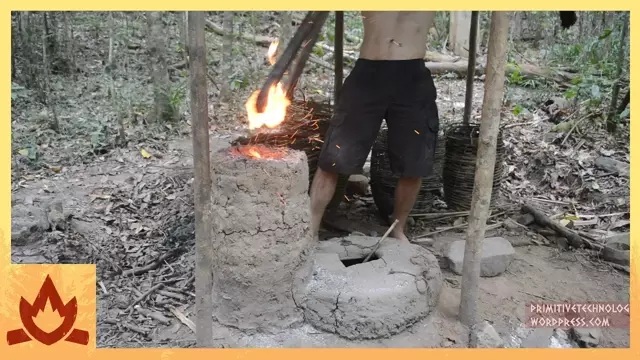2017-08-25
[public] 17.1M views, 260K likes, dislikes audio only
Blower description
The purpose of this project was to test a simplified blower design connected to a furnace. I purposely did this to show that people in most natural environments should be able to replicate this design without difficulty. This blower differed from the previous one in several ways to simplify the construction method.
Firstly, the impellor was simply a stick as a rotor with a 40 cm wide rectangle of bark tied into a split in its end with a bark fibre cordage. A stone with a pit carved into it acted as a socket for the lower half of the rotor to spin in. If spun in the dirt the rotor can drill down and the position of the impellor can reach ground level causing the blades to bump into rocks and dirt. Later, I plastered the stone socket into the ground with mud to hold it securely in position (not shown in the video, just be aware of this solution if the socket shifts around too much).
Secondly, the housing for the blower was made in situ of ordinary mud (dirt and water on site). It was a bit more than 40 cm in internal diameter. The walls of the housing were solid mud and the roof was made of sticks covered with mud. An opening more than half the length of the impellor was left in the roof to remove the impellor for maintenance and to admit air into the blower during operation. In use, the portion of this opening near the front of the blower was covered with a tile. If left opened the blower still worked but covering it improved performance by preventing air escaping near the front. In places where water is not available, a housing shaped pit covered with sticks and dirt might work instead.
Finally, a simple length of cordage was used to drive the rotation of the impellor. This cord was placed in a notch carved into the top of the impellor rotor. The cord was wrapped around the rotor about 2.5 times. During operation the cords were pulled outwards causing the rotation. When fully unwound, the momentum of the impellor then wrapped the cord back around in the other direction. Then the cords were pulled outwards again causing the impellor to spin in the other direction. Note that this is a centrifugal blower with a symmetrical housing, therefore it doesn’t matter whether the fan spins one way or the other (clockwise or anti clockwise), the blower will always suck air in to its open top and force it into the furnace.
This design is easy to make and use. It can be made with minimal materials by unskilled people. The impellor design is simple yet effective. A stick, some bark and lashing of some sort should be available in most areas. The housing being made from mud, is easily sourced also. For the drive mechanism, I chose this method because the first blower I built had too many parts. There was a frame made of wood and vine to hold the rotor in place which kept causing issues with the rotor seizing or jumping out of the socket. Also, the bow that was used to drive the rotor added unnecessary complexity. In the new design, the simple cord in the notch of the rotor did away with the frame and the bow of the old design and the associated difficulties.
Furnace experiments
The blower was used to power a furnace attached to the front of it. Note that with minimal materials, the blower could simply force air into a hole in the base of the furnace and work satisfactorily. But I wanted to test a different configuration so I used clay grate from a previous kiln I made. Fuel in the form of wood and charcoal was used in this furnace by being placed on top of the grate instead of under it. During operation, the blower forced air up through the grate into the burning fuel bed increasing the rate of heat production relative to the use of natural draft (convection) alone.
I made 3 pots and fired them with charcoal. The first pot was painted with iron bacteria (iron oxide being the active ingredient). When fired, the oxide melted slightly showing minimal glazing. The clay became quite hard, possibly stoneware. The second pot was painted with wood ash and placed on a three sided clay plinth to hold the pot in the position of highest temperature in the fuel bed. The pot softened and sagged apart catastrophically. But the ash glaze gave a dark green smooth finish (difficult to see in the video). Finally, a pot was place upside down on the grate and a cylindrical brick made of iron bacteria, charcoal powder and wood ash was put on top of this. The brick melted over the pot, covering it in a viscous blob of slag rather than a thin glaze. On inspection, the slag had 1mm sized spheres of metallic iron in it. Some of these were picked out and stored in a pot. The reason for experiments like these to gain knowledge that might be of practical use in future projects that have not yet been determined.
Wordpress: https://primitivetechnology.wordpress.com
Patreon page: https://www.patreon.com/user?u=2945881
I have no face book page, instagram, twitter etc. Beware of fake pages.
http://www.penguinrandomhouse.com/primitive-technology
/youtube/video/i-WYT2UotIc?t=2
/youtube/video/SjK2XlNE39Q
/youtube/channel/UCAL3JXZSzSm8AlZyD3nQdBA
/youtube/video/nG-rNHgFxhs
/youtube/video/RZGAYzItazw
http://www.penguinrandomhouse.com/primitive-technology

